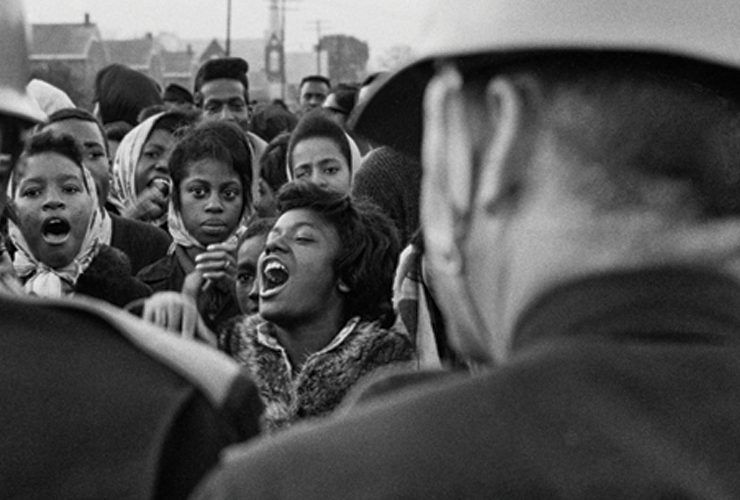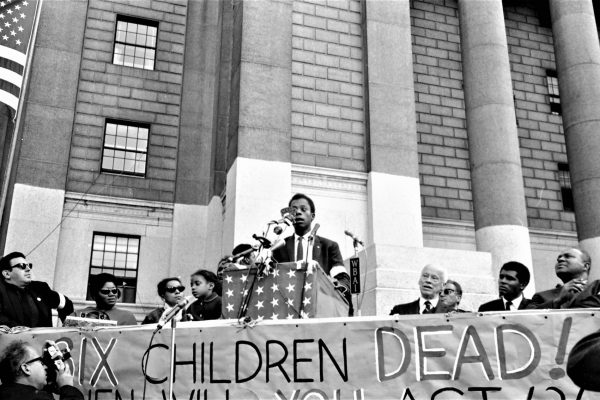This essay appears in print in Fifty Years Since MLK.
“I am convinced,” Martin Luther King, Jr., said in 1967, “that if we are to get on the right side of the world revolution, we as a nation must undergo a radical revolution of values.” This is one of the more resounding lines from King’s corpus and one of the most frequently cited. It is often taken to capture the essence of King’s later radicalism, a sense of the political commitment and moral urgency that he ascribed to a second, more “substantive” phase of his life’s work: to organize an assault on the “evil triplets,” the racism, violence, and cycles of impoverishment that, like a kind of organic compound, had conspired to give life force to the only U.S. society the world had yet known.
It is no secret that King became increasingly outspoken in his dissatisfaction with capitalism, especially the ways in which racism and violence had been interwoven into the structural workings of the U.S. economy. But if, as Brandon Terry suggests, King can still help us to “radically challenge” the United States’ congenital deformities, and if, as King himself has suggested, any political prescription “rests with the accurate diagnosis of the disease,” then we might reflect a bit more on the nature, and legacy, of King’s mature critique of capitalism. How is King’s call for a “revolution of values” affected by the production and circulation of value in capitalist society?
Though King’s analysis moved beyond, and often against, key assumptions and conceptual tools of Marxist thought, Karl Marx’s way of thinking about capital as “value in motion” is suggestive and broadly consistent with King’s thinking. Consider Marx’s account of how the “commodity-form” under capitalism, what we might describe as the market actor’s singular and largely compulsory focus on the exchange of money, “conceals a social relation.” Marx argued that the coordination of human labor and activity, indeed the kinds of human interdependencies that King cataloged under the rubric of an “inescapable network of mutuality,” had become sustained in the modern world by a logic of capital accumulation, by a distinctive pressure put upon market actors to base decisions largely on information available through price signals, and to pursue not only profit, but also sustained growth through the creation of viable outlets for reinvestment. What we are compelled to value and devalue in capitalist society is largely dependent upon its commodification and movement through cycles of accumulation and reinvestment. This movement, this “value in motion,” is itself dependent upon the reproduction of social inequalities, which have significant temporal and spatial dimensions, as well as discernible racial dimensions.
As Jodi Melamed reminds us, “Capital can only be capital when it is accumulating, and it can only accumulate by producing and moving through relations of severe inequality among human groups.” Such accumulation requires “loss, disposability, and the unequal differentiation of human value, and racism enshrines the inequalities that capitalism requires.” Melamed also points out, following Ruth Wilson Gilmore, that the racial inequalities historically endemic to the circulation of capital are reproduced through “technologies of anti-relationality,” or normalized, and normally disavowed, processes by which “forms of humanity are separated (made ‘distinct’) so that they may be ‘interconnected’ in terms that feed capital.” Part of the point here is that any prospect for collective life, any chance for authentic and racially integrated human and democratic interaction, is routinely delimited by territorialization, ghettoization, incarceration, various modes of racialized partition that condition the possibility of “world-systems of profit and governance.” The type of critical analysis that can help to expose this—what we might refer to, following Cedric Robinson, as the critical theory of racial capitalism—is broadly consistent with, if not implied by, King’s later attentiveness to the economic geographies of racial segregation or the ways in which, as King put it in 1967, “depressed living standards for Negroes . . . are a structural part of the economic system in the United States.”
Terry is right to say that, for King, any adequate challenge to racism requires consideration of psychological and ideological as well as sociopolitical factors. But we need to reconstruct King’s dissatisfaction with capitalism in order to build out this latter dimension, which is so often missed by conventional projections of King as a kind of idealist or moral philosopher. That our human relationships are mediated by commercial society and its value-form—that, as King so often lamented, we have become a “thing-oriented” rather than a “person-oriented society”—is no mere illusion. If what appears before us is a world marked by “material relations between persons and social relations between things,” such relations appear, as Marx famously put it, “as what they really are.” Under capitalism, our failure to see, to respect, and to make decisions based upon genuinely human interactions, indeed our failure to treat other people as human beings, is less a psychological or epistemic failure than a structured impossibility.
And so perhaps the task in front of us, the prescription that a “second phase” diagnosis calls for, is not merely to recover our morality or to will ourselves to treat human beings as human beings rather than as things. In order even to put ourselves in a position to cultivate this sort of collective memory and will, we need a wholesale transformation of the sociopolitical form of domination, what King referred to as a “restructuring of the whole of American society.” Perhaps what we need, more proximately, is a mode of apprehension that can include but also push beyond the epistemic, beyond efforts to debunk racist ideology and false consciousness, as important as such efforts are, and out into the ontological, into a political confrontation with what Robinson has called the “actual being” of racial capitalism.
So, to extend the spirit of Terry’s analysis, I suggest that we consider, as an integral part of the King legacy, the question of how King’s call for a revolution of values is complicated by the production and circulation of value in capitalist society. In his outward pronouncements at least, King often projected an assurance that “there is nothing except a tragic death wish to prevent us from reordering our priorities.” But surely the obstacles, from ideological and fetishistic obfuscation to the emboldened interests of counterrevolution, are far more formidable, far more complex, than King let on.
This, of course, King knew all-too well. In the last years of his life especially, King battled privately through fits of depression and a recurring sense that he was chasing a fool’s errand. Many in his inner circle, including veteran anti-capitalist soldiers such as Bayard Rustin and Stanley Levison, sought to persuade King that the United States was just not yet ready for radical political-economic restructuring. And yet King soldiered on. Part of what he gave us, in the last years especially, was the rudiments of a compelling and generative critical theory, a diagnostic account of racial capitalism. This was no fool’s errand. Perhaps now more than ever, King’s critique can help to motivate incisive thinking about the obstacles that foreclose realization of a more just world as well as the enduring activist legacy of the black radical tradition.








